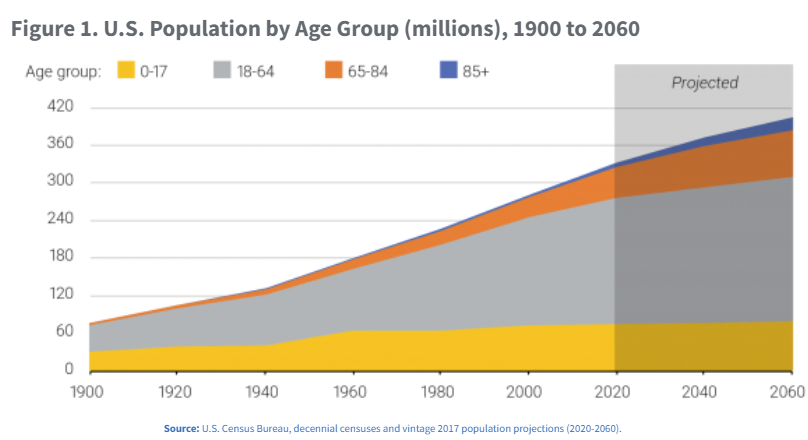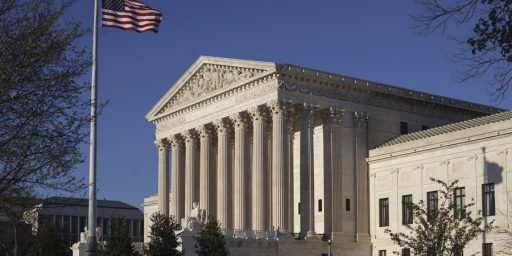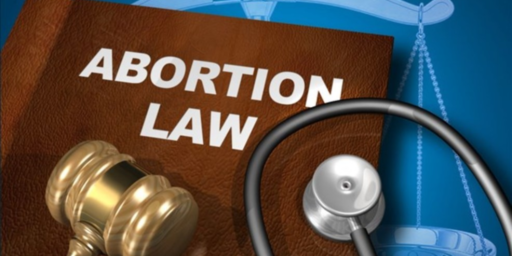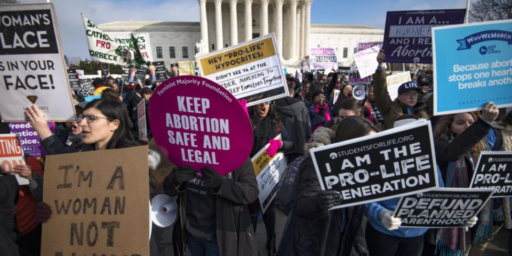Americans Having More Abortions
A decades-long decline has ended.

When I saw the NPR headline “With Roe on the precipice, Americans are having more abortions,” I got the impression that there was a rush to clinics to get under the wire. But, no, that’s not the case.
The number of patients seeking abortions in the U.S. rose in 2020, reversing some 30 years of decline in the number of abortions.
That finding, in a report released by the Guttmacher Institute on Wednesday, comes as the Supreme Court appears poised to overturn decades of precedent guaranteeing abortion rights.
The number of abortions recorded by Guttmacher’s Abortion Provider Census rose to 930,160 in 2020, an 8% increase compared with 2017, the last time the data was collected.
“The long-term decline in abortion is over, and the number of abortions in the United States is actually increasing,” said Rachel K. Jones, a research scientist who co-authored an analysis of the data for Guttmacher, a research group that supports abortion rights.
The report lists several potential factors that may have contributed to the increase, including increased abortion access in some states through Medicaid expansion or the growth of abortion funds that help low-income people cover the costs of obtaining an abortion.
The report also notes that the Trump administration’s overhaul of the federal Title X family planning program in 2019 prompted some health centers to withdraw, which resulted in fewer patients receiving contraception through the program.
The increase in abortions took place nationwide, with the largest uptick in the West and Midwest. But at the state level, the numbers varied widely depending on local circumstances. For example, as a growing number of abortion restrictions in Missouri prompted more patients to cross state borders for care, neighboring Illinois — a state with far fewer such laws — saw a 25% increase in abortions between 2017 and 2020.
Given that states have been pushing the envelope of late in anticipation of a more conservative Supreme Court whittling away or eliminating the Constitutional right to abortion announced in Roe, it seems unlikely that the legal regime is the answer. And, while I support making contraception free and easily available, I’m skeptical that programmatic change contributed that much to an 8 percent uptick.
My initial instinct was that the explanation is simply demographic: there are more women of child-bearing age and the study is simply in raw numbers. And, sure enough, that’s happening:

Alas, my hypothesis wouldn’t seem to explain a sudden reversal of a decades-long trend since the adult population has been steadily increasing.
I’ve had no luck finding longitudinal data that’s more refined. There are plenty of over/under 18 studies and ones like this one that lump 18-64 together. Something like 16-30 would be more useful in examining this theory. I’ve found state-level data that breaks it down into smaller subsets but not across time. The closest thing I found was a 2013 AEI blog post projecting that “By 2020 or 2025, the largest age cohorts will all be under 40.”
A WSJ report (“U.S. Abortion Rate Ends Decadeslong Decline“), alas, clarifies the study and eliminates my theory:
Both the number of abortions performed and the rate of them increased between 2017 and 2020, according to new research from the Guttmacher Institute, a policy group that supports abortion rights and tracks national and state statistics.
There were 930,160 abortions performed in the U.S. in 2020—an 8% jump from 862,320 in 2017. The abortion rate per 1,000 women ages 15 to 44 increased to 14.4 in 2020 from 13.5 in 2017, the report said. The data measure the number of abortions provided in clinical settings.
While we would expect the raw number of abortions to increase as the number of women of child-bearing age increases, the fact that the rate went up (albeit modestly) tells us that something else is going on.
The report also clarifies that
Most abortions—more than 90%—are performed before or at 13 weeks of pregnancy, according to a Centers for Disease Control and Prevention study of abortions that occurred in 2019. Less than 1% are performed after 20 weeks, according to the CDC.
This means that, theoretically at least, even the draconian new laws on the books wouldn’t have much impact.
And this conjecture confuses me:
Abortions performed in the U.S. today could differ from the 2017-20 Guttmacher Institute data. Those figures measure abortions before new restrictions in Texas and Oklahoma took effect and reduced the number of abortions performed there.
Given that the number and rate is up, I’m not sure what they’re driving at there.






Reduced access to birth control surely has to factor in (as stated above), and lockdowns challenged many partnerships, so the pandemic likely has played into this too. We can’t discount economic factors, which have also been dramatically affected by the pandemic.
The measurement they are using to say it is up was from 2020. They are saying that today, in 2022, it may be different, given “new restrictions in Texas and Oklahoma took effect and reduced the number of abortions performed there. “
@SKI: Ah. Yes, that makes sense—but it’s a poor way to express that idea.
Headline: “Abortions rose for first time in decades under evangelical darling Donald Trump.”
Headline/story if media applied its Biden/Hillary double standard narratives to Republicans: “Trump’s abortion spike threatens GOP hold on white Christian base”
[Insert push polls showing young evangelicals abandoning Trump and three Trump-skeptical quotes from Utah Mormons.]
– Chris Cillizza or Chuck Todd, probably
I would be wary of using 2020 as a reference year for anything. A global pandemic might not be the best time to start a family. Births were down, according to the CDC.
https://www.cdc.gov/nchs/data/vsrr/vsrr012-508.pdf
2020 is going to be a weird outlier in statistics for generations, and produce weird apparent trends for everyone’s pet issue in the short term. Remember when the price of oil futures went negative?
And something like 99.99% of them are done for medical reasons, either the fetus is not viable or the pregnancy is a threat to the health of the woman.
They are making some large and categorical statements based on a single data point. Maybe they are right, but I would sure want to see more than one year’s data before stating categorically that a multi-year trend has reversed.
My initial reaction to the headline was, “get ’em while they last!”
Admittedly a rather dark observation on the impending SCOTUS decision.